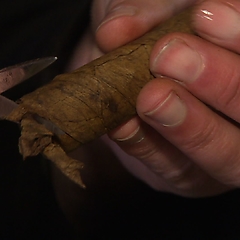Papermaking is creating paper from pulp. This may be pulp from old paper or any plant or tree, as long as it has got fibres. The fibres are torn, cut or shredded into pieces and soaked in water until it becomes a paste. In a scooping vat the mixture (between 1 and 2% fibres, the rest water) is evenly spread. The papermaker moves a screen in a loose frame (the deckle frame) horizontally through the vat until above the water surface. The pulp remains in the sieve. When most of the water has run out, the sieve is turned around with a pressing movement onto a wet felt cloth (this procedure is called koetsen). This sheet-to-be is covered with a felt cloth, on which a new sheet of freshly scooped paper can be put. When a stack has been formed in this way, it is pressed until all the water has gone. Then the sheets can be hung to dry on lines. When dry, they are once more pressed for at least one day and then the paper can get an after-treatment, like a coating (a layer of glue, to make it suitable for writing in ink) or a colour.



